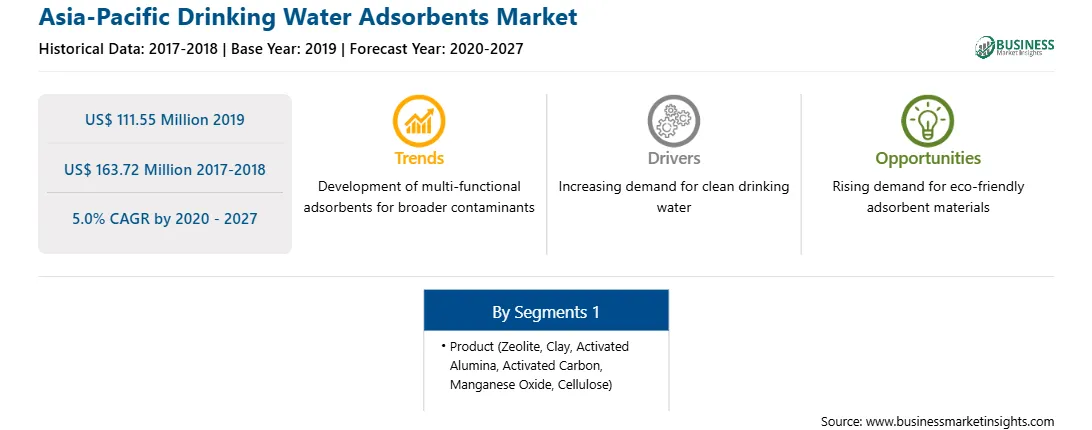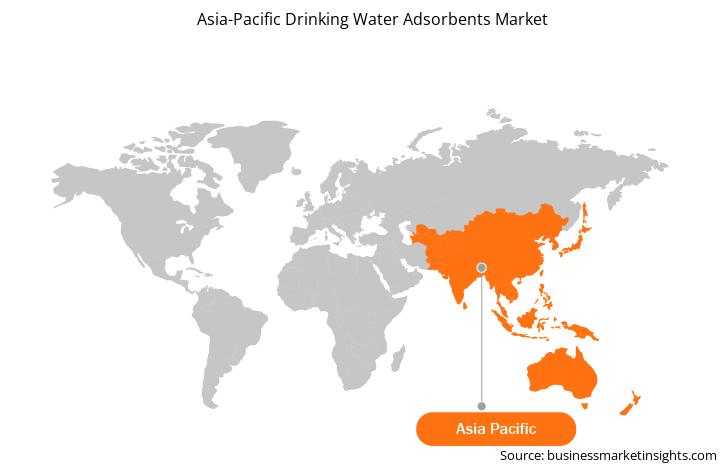APAC continent comprises several developing economies such as China, India, Japan, South Korea, and Australia, among others. These emerging countries are witnessing an upsurge in the middle-class population, along with growth in urbanization, which offers ample opportunities for the key market players in the drinking water adsorbents market. The drinking water adsorbents market in the countries of APAC has experienced a huge shift over the years. APAC is the largest continent in the world and has shown ample opportunities for this market. The growing concern about water pollution has resulted in the creation of stringent laws, which would increase the demand for drinking water adsorbents even more. Because of their superior properties in terms of heavy metal ion removal, governmental bodies such as municipal corporations are promoting the use of adsorbents for water treatment. Rising groundwater contamination from harmful contaminants such as arsenic, fluoride, sewage, and industrial effluents is having a substantial negative effect on the health of the South Asian population. This is expected to increase the prominence of water treatment processes for removing pollutants from groundwater resources, driving the regional market. Also, adsorbents derived from rice husk for purifying water is a major factor driving the APAC drinking water adsorbents market.
The ongoing COVID-19 pandemic is having a negative impact over APAC region. The India and China are the two most populated countries as well as manufacturing hubs in the APAC region. The strict lockdown and social isolation in China have negatively impacted the manufacturing as well as production of numerous equipment and machinery for several weeks, resulting in shrinking its country economy. Moreover, the country also isolated its import as well as export of critical raw materials and industrial equipment for numerous industry vertical impacting the supply chain of various end-user industries. Similarly, India also imposed a nationwide lockdown to mitigate the increasing number of COVID-19 cases across the country. Additionally, the closure of several retailers, distributors, and other important distribution channels also has reduced the availability of drinking water adsorbents or its related component from other region-based market players. The governments of various countries in APAC are taking possible steps to reduce the COVID-19 effects, which in turn will negatively impact the revenue generated by the drinking water adsorbents market.

Strategic insights for the Asia-Pacific Drinking Water Adsorbents provides data-driven analysis of the industry landscape, including current trends, key players, and regional nuances. These insights offer actionable recommendations, enabling readers to differentiate themselves from competitors by identifying untapped segments or developing unique value propositions. Leveraging data analytics, these insights help industry players anticipate the market shifts, whether investors, manufacturers, or other stakeholders. A future-oriented perspective is essential, helping stakeholders anticipate market shifts and position themselves for long-term success in this dynamic region. Ultimately, effective strategic insights empower readers to make informed decisions that drive profitability and achieve their business objectives within the market.

| Report Attribute | Details |
|---|---|
| Market size in 2019 | US$ 111.55 Million |
| Market Size by 2027 | US$ 163.72 Million |
| Global CAGR (2020 - 2027) | 5.0% |
| Historical Data | 2017-2018 |
| Forecast period | 2020-2027 |
| Segments Covered |
By Product
|
| Regions and Countries Covered | Asia-Pacific
|
| Market leaders and key company profiles |
The geographic scope of the Asia-Pacific Drinking Water Adsorbents refers to the specific areas in which a business operates and competes. Understanding local distinctions, such as diverse consumer preferences (e.g., demand for specific plug types or battery backup durations), varying economic conditions, and regulatory environments, is crucial for tailoring strategies to specific markets. Businesses can expand their reach by identifying underserved areas or adapting their offerings to meet local demands. A clear market focus allows for more effective resource allocation, targeted marketing campaigns, and better positioning against local competitors, ultimately driving growth in those targeted areas.

The drinking water adsorbents market in APAC is expected to grow from US$ 111.55 million in 2019 to US$ 163.72 million by 2027; it is estimated to grow at a CAGR of 5.0% from 2020 to 2027. Activated carbon can remove natural organic matter (NOM) from drinking water and can be used as an integral component for water filtration systems. Activated carbon has swept across the industrial world and has become an essential component to purify water. Activated carbon is used by both large- and small-scale good. Activated carbon helps in eliminating impurities from large-scale, community-wide water supplies as well as residential applications on a smaller scale. Moreover, due to its exceptionally rare physical properties such as excellent pore properties including high surface area and wide pore size distribution. Activated carbon is mostly used as drinking water adsorbents. Further, it can eliminate dissolved pollutants such as flavor, odor, color, and harmful organisms. In addition, with the inclusion of carbon and hydrogen in their composition, activated carbon acts as an effective product for removing organic pollutants. Also, an increase in demand for activated carbon for the removal of turbidity and naturally occurring organic matter is expected to benefit the market growth.
Based on product, the APAC drinking water adsorbents market is categorized into zeolite, clay, activated alumina, activated carbon, manganese oxide, cellulose, and others. In 2019, the activated carbon segment dominated the market by accounting for highest market share.
A few major primary and secondary sources referred to for preparing this report on the drinking water adsorbents market in APAC are company websites, annual reports, financial reports, national government documents, and statistical database, among others. Major companies listed in the report are BASF SE, Dupont, Evoqua Water Technologies LLC, Geh Wasserchemie, KURARAY CO. LTD, and Purolite.
The Asia-Pacific Drinking Water Adsorbents Market is valued at US$ 111.55 Million in 2019, it is projected to reach US$ 163.72 Million by 2027.
As per our report Asia-Pacific Drinking Water Adsorbents Market, the market size is valued at US$ 111.55 Million in 2019, projecting it to reach US$ 163.72 Million by 2027. This translates to a CAGR of approximately 5.0% during the forecast period.
The Asia-Pacific Drinking Water Adsorbents Market report typically cover these key segments-
The historic period, base year, and forecast period can vary slightly depending on the specific market research report. However, for the Asia-Pacific Drinking Water Adsorbents Market report:
The Asia-Pacific Drinking Water Adsorbents Market is populated by several key players, each contributing to its growth and innovation. Some of the major players include:
The Asia-Pacific Drinking Water Adsorbents Market report is valuable for diverse stakeholders, including:
Essentially, anyone involved in or considering involvement in the Asia-Pacific Drinking Water Adsorbents Market value chain can benefit from the information contained in a comprehensive market report.